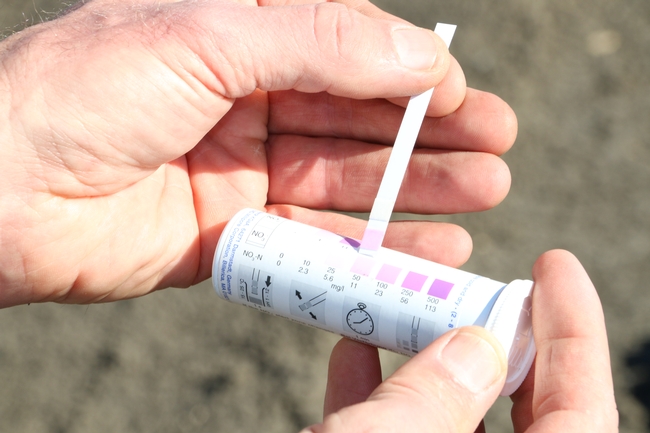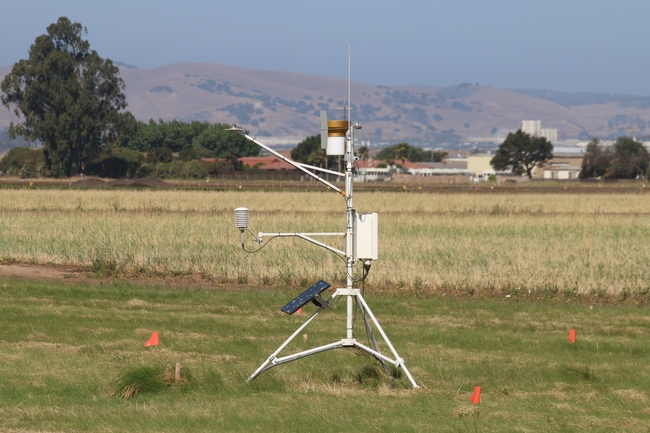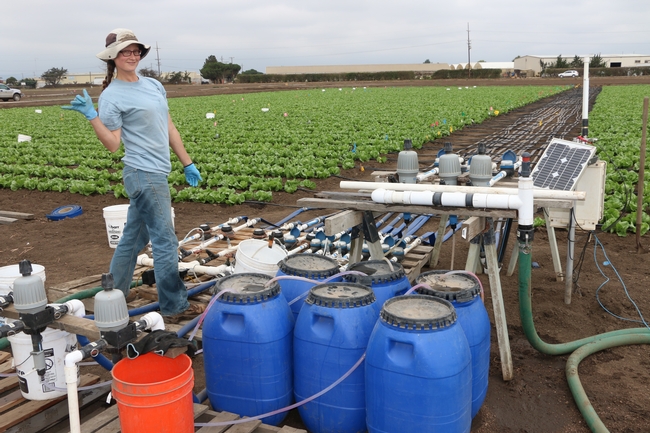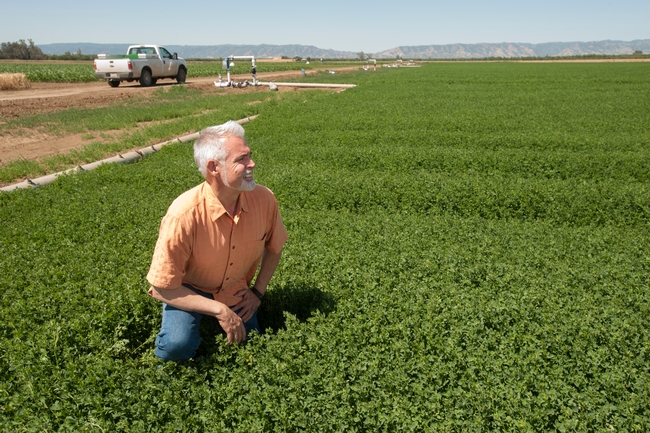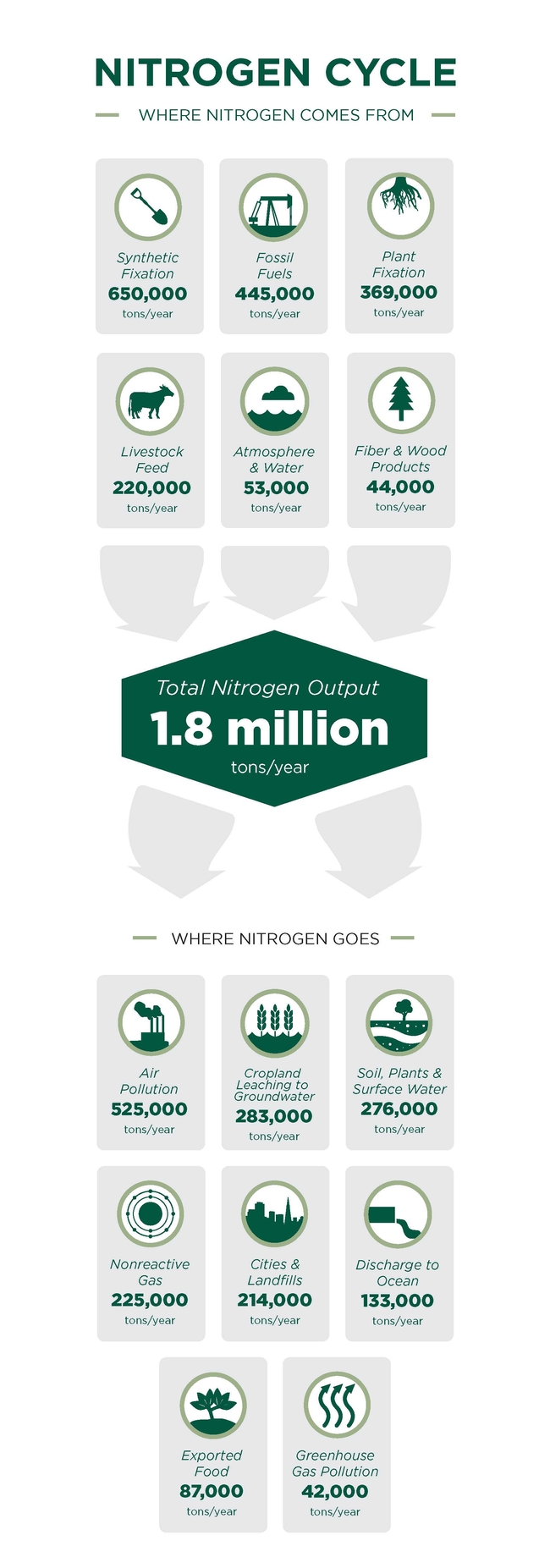Posts Tagged: Agricultural Sustainability Institute
California nitrogen assessment presents opportunities for improvement
Plants need nitrogen to grow, but excess nitrogen – from livestock facilities, septic systems, car exhaust and other sources – that escapes into groundwater and the air can impact the environment, human health and the climate.
A new report from the Agricultural Sustainability Institute at UC Davis offers a big picture look at the scale and impacts of nitrogen in California. According to the California Nitrogen Assessment, excess nitrogen in the state comes primarily from agriculture and fossil fuel combustion.
The report, published by UC Press, offers a scientific foundation to develop practices and policies that allow nitrogen's benefits while reducing the risk.
For years, UC Agriculture and Natural Resources scientists have been working with farmers throughout the state to refine fertilizer management, irrigation efficiency and other farming practices to manage nitrogen, and the work continues.
The following are some examples of UC ANR research and extension projects underway.
App helps farmers better manage nitrogen fertilizer and water
Growers can use CropManage, developed by Michael Cahn, UC Cooperative Extension advisor in Monterey County, and UC ANR Communication Services and IT staff, to track and manage water and nitrogen fertilizer applications for their crop fields. The online application can be used on mobile devices or computers to help farmers use two tools to conserve water and make better use of nitrogen fertilizer while maintaining crop productivity and quality. Growers use the soil nitrate quick test in the field to measure the nitrogen level of their soil and the app to determine the optimal level of nitrogen fertilizer to apply based on UC ANR research on crop nitrogen use. CropManage also recommends water needs of a crop from weather station data and crop development models.
Matching nitrogen applied to crop need improves efficiency
Richard Smith, UC Cooperative Extension advisor in Monterey County, is leading several research projects evaluating the nitrogen requirements of vegetables including including cole crops, spinach, baby lettuce, a salad mix and cilantro. Smith is evaluating crop rotations with broccoli to scavenge nitrogen from the soil profile. He is also evaluating slow-release fertilizers to minimize nitrate leaching losses in shallow-rooted crops such as baby lettuce and spinach in the Salinas Valley.
Wood chips remove nitrogen in tile drain water
Using wood chips and supplemental carbon sources, Tim Hartz, UC Cooperative Extension specialist in the UC Davis Department of Plant Sciences, worked with Cahn and Smith to refine a process to remove nitrate from tile drain water, which typically is very high in nitrate. The carbon in the wood chips supports the activity of anaerobic bacteria that chemically reduce the nitrate to N2, a benign gas.
Irrigation water fertilizes vegetables
Water quality regulations in many regions of California now require farmers to report the amount of nitrogen fertilizer that they apply to their fields and the nitrate concentration of their irrigation water. Smith, Hartz and Cahn have just finished three seasons of field trials that demonstrated that the nitrate in groundwater supplied a substantial portion of the fertilizer requirements for lettuce and broccoli. By accounting for the nitrate in irrigation water and using the soil nitrate quick test to monitor soil nitrogen levels, growers may be able to significantly reduce the amount of fertilizer nitrogen they apply to vegetable crops.
Micro-irrigation offers almond growers a tool to control leaching
The majority of almond growers apply fertilizer through micro-irrigation systems and an increasing number of growers are irrigating with water that is saline. Patrick Brown, professor in the UC Davis Department of Plant Sciences, is studying how to use micro-irrigation to reduce nitrate leaching and manage soil salinity by varying the frequency of irrigation and the length of time water is applied during irrigation.
Managing irrigation to reduce nitrate leaching
To identify the best irrigation management practices to control soil salinity and to minimize nitrate leaching to groundwater, Laosheng Wu, professor and UC Cooperative Extension specialist in the UC Riverside Department of Environmental Sciences, is using computer simulation to consider soil, water, crop nitrogen demand and fertilization with irrigation methods. In collaboration with UC Cooperative Extension advisors, Wu is conducting field experiments on alfalfa in Imperial County, almonds in the Central Valley and avocados at South Coast Research & Extension Center in Orange County to validate the simulations.
Online tool being developed to estimate soil nitrogen mineralization rates
To develop a tool for growers and crop advisers to estimate soil nitrogen, Daniel Geisseler, UC Cooperative Extension specialist in the Department of Land, Air, and Water Resources at UC Davis, is gathering data throughout California to estimate field-specific nitrogen mineralization rates. This project, funded by UC ANR's California Institute for Water Resources, will use nitrogen mineralization data to develop an online tool to help growers adjust their applications of fertilizer. The tool has the potential to increase nitrogen use efficiency in crop production, resulting in lower risks of nitrate leaching to groundwater.
Nitrogen management training for Certified Crop Advisers
Between 2014 and 2016, approximately 900 Certified Crop Advisers participated in a nitrogen management training program coordinated by UC ANR's California Institute for Water Resources with support from CDFA's Fertilizer Research and Education Program. The technical and applied training improves CCAs' understanding of sound nitrogen management practices to make informed recommendations to growers.
The California Nitrogen Assessment book
The book, “The California Nitrogen Assessment: Challenges and Solutions for People, Agriculture, and the Environment,” is available for purchase at ucpress.edu. The 20-page executive summary can be downloaded for free at asi.ucdavis.edu.
This story is also available in Spanish: "La evaluación del nitrógeno en California ofrece oportunidades para mejorar http://ucanr.edu/sites/Spanish/Noticias/boletines/?uid=6884&ds=199
First state-level nitrogen assessment shows the state of the science on nitrogen use and pollution
California paves the way for reconciling agriculture and the environment
Nitrogen is essential for agriculture but also has health and environmental impacts. The California Nitrogen Assessment, a new report from the Agricultural Sustainability Institute at the University of California, Davis presents a big picture of the scale and impacts of nitrogen in the state. The report, published by UC Press, offers a scientific foundation to develop practices and policies that balance nitrogen's benefits and harm.
It's easy for nitrogen to become too much of a good thing, according to the report, which is the first state-level nitrogen assessment. Excess nitrogen can pollute groundwater and air, and impacts the environment, human health, and climate change.
The report shows that excess nitrogen in the state comes primarily from agriculture and fuel combustion.
“This problem was created by all of us,” said lead author Tom Tomich, director of the Agricultural Sustainability Institute at UC Davis. “Nitrogen is an issue that affects and is affected by every Californian.”
Nitrogen in balance
The seven-year, multi-institutional assessment identifies how much nitrogen enters the state, where it is used, and its eventual fate. It consolidates existing scientific knowledge and weighs options for addressing nitrogen management.
“Many programs in California have been recently put in place to help balance the benefit and harm of nitrogen use,” Tomich said. “The California Assessment hopes to contribute to long term solutions and we see farmers as the leaders in positive change.”
Agriculture the major source of California's nitrogen
Each year, about 1.8 million tons of nitrogen enter California. Agriculture represents the largest source of California's nitrogen imports from synthetic fertilizer, livestock feed, and nitrogen-fixing crops, which pull nitrogen from the air and convert it into a usable plant nutrient.
Nitrogen fertilizer helps California produce 21 percent of the nation's dairy commodities and more than half of the nation's fruits and vegetables.
However, vegetable and fruit crops throughout the state use only half of the nitrogen applied to them on average. For livestock, only about a quarter of the nitrogen in animal feed becomes meat or dairy products. The remaining 75 percent becomes manure, which can emit nitrogen into the air as ammonia, a known air pollutant.
Much excess nitrogen from crops leaks into soil and eventually the state's groundwater. Sixteen percent of the state's net nitrogen imports each year, accumulate in groundwater, and 11 percent of nitrogen from crop land and livestock is lost as air pollution.
Nitrogen in groundwater linked to health issues
Nitrogen leaches into groundwater as nitrate, which has been linked with blue-baby syndrome in infants, adverse birth outcomes, and various cancers. While most adults consume more nitrate through food than through drinking water, people who rely on contaminated wells may take in the majority of their nitrate through drinking water.
Parts of the state regularly fail to meet federal drinking water standards for nitrates, and previous reports have shown low-income Latino communities in agricultural regions are the most exposed to groundwater nitrate contamination.
Excess nitrogen in the environment can have detrimental impacts on crop yields, native species and biodiversity, as well.
Nitrogen, fossil fuels, and air pollution
Fossil fuel combustion is responsible for nearly a quarter of the nitrogen coming into the state in the form of nitrogen oxides, which contribute to ozone formation, and ammonia, a component of particulate matter.
Well-established scientific evidence links ozone and particulate matter to poor respiratory and heart health.
Much of the nitrogen oxides and ammonia produced in California are transported downwind from California, making the state a major exporter of nitrogen air pollution.
A very small amount of the state's nitrogen, 2 percent, is released as nitrous oxide, a potent greenhouse gas. Nitrous oxide emissions account for 4 percent of California's total greenhouse gas emissions.
Emissions have declined since 1980 as regulations have pushed fuel efficiency advancements, but nitrogen-related air pollutant levels still exceed state recommendations in many areas.
The path forward
The dispersed, “non-point” nature of nitrogen pollution makes achieving solutions especially challenging. A one-size-fits-all approach will not work for managing nitrogen.
The report highlights practices farmers and ranchers can use to decrease nitrogen losses and save money, such as reducing nitrogen application rates and timing nitrogen application closely with irrigation, practices many farmers in California already are using.
“California has amazing resources to address this issue,” said Rich Rominger, a California farmer and former Director of the California Department of Food and Agriculture. “The state has skilled and motivated farmers and a university system that can continue to dive deep into our unanswered questions about nitrogen. California is often looked to as both an agricultural innovator and an example of strong environmental policy. How we deal with nitrogen can enhance our leadership in these areas.”
The California Nitrogen Assessment was funded primarily by the David and Lucille Packard Foundation, as well as by the UC Division of Agriculture and Natural Resources (UC ANR), and the UC ANR Kearney Foundation of Soil Science.
The book is available at ucpress.edu, and summary materials are available at asi.ucdavis.edu.
More information:
Read the executive summary.
The book, The California Nitrogen Assessment: Challenges and Solutions for People, Agriculture, and the Environment,is available at ucpress.edu.

